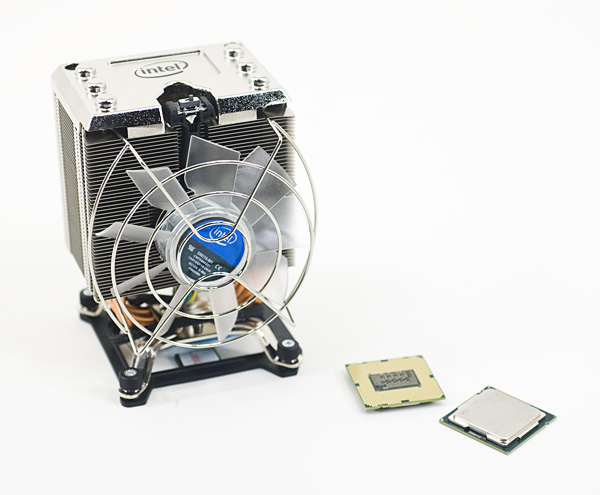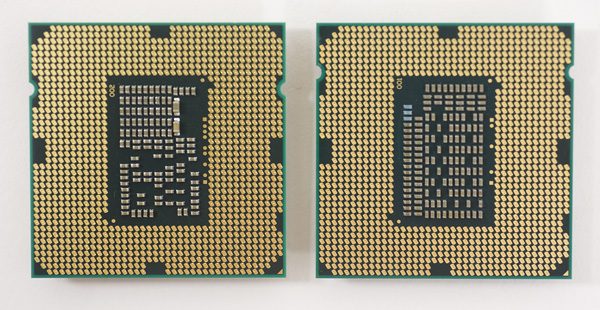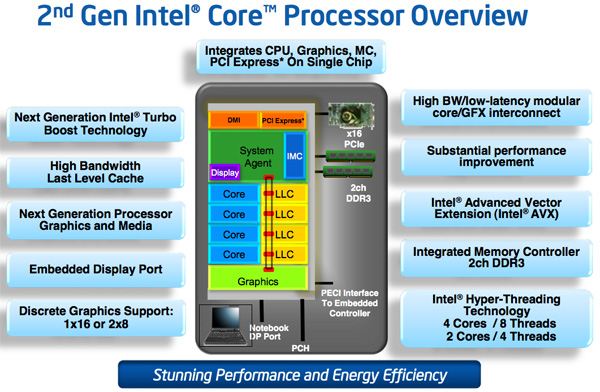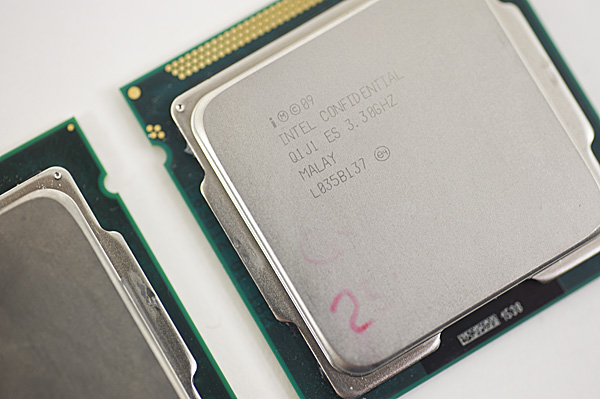The Sandy Bridge Review: Intel Core i7-2600K, i5-2500K and Core i3-2100 Tested
by Anand Lal Shimpi on January 3, 2011 12:01 AM ESTIntel never quite reached 4GHz with the Pentium 4. Despite being on a dedicated quest for gigahertz the company stopped short and the best we ever got was 3.8GHz. Within a year the clock (no pun intended) was reset and we were all running Core 2 Duos at under 3GHz. With each subsequent generation Intel inched those clock speeds higher, but preferred to gain performance through efficiency rather than frequency.
Today, Intel quietly finishes what it started nearly a decade ago. When running a single threaded application, the Core i7-2600K will power gate three of its four cores and turbo the fourth core as high as 3.8GHz. Even with two cores active, the 32nm chip can run them both up to 3.7GHz. The only thing keeping us from 4GHz is a lack of competition to be honest. Relying on single-click motherboard auto-overclocking alone, the 2600K is easily at 4.4GHz. For those of you who want more, 4.6-4.8GHz is within reason. All on air, without any exotic cooling.
Unlike Lynnfield, Sandy Bridge isn’t just about turbo (although Sandy Bridge’s turbo modes are quite awesome). Architecturally it’s the biggest change we’ve seen since Conroe, although looking at a high level block diagram you wouldn’t be able to tell. Architecture width hasn’t changed, but internally SNB features a complete redesign of the Out of Order execution engine, a more efficient front end (courtesy of the decoded µop cache) and a very high bandwidth ring bus. The L3 cache is also lower and the memory controller is much faster. I’ve gone through the architectural improvements in detail here. The end result is better performance all around. For the same money as you would’ve spent last year, you can expect anywhere from 10-50% more performance in existing applications and games from Sandy Bridge.
I mentioned Lynnfield because the performance mainstream quad-core segment hasn’t seen an update from Intel since its introduction in 2009. Sandy Bridge is here to fix that. The architecture will be available, at least initially, in both dual and quad-core flavors for mobile and desktop (our full look at mobile Sandy Bridge is here). By the end of the year we’ll have a six core version as well for the high-end desktop market, not to mention countless Xeon branded SKUs for servers.
The quad-core desktop Sandy Bridge die clocks in at 995 million transistors. We’ll have to wait for Ivy Bridge to break a billion in the mainstream. Encompassed within that transistor count are 114 million transistors dedicated to what Intel now calls Processor Graphics. Internally it’s referred to as the Gen 6.0 Processor Graphics Controller or GT for short. This is a DX10 graphics core that shares little in common with its predecessor. Like the SNB CPU architecture, the GT core architecture has been revamped and optimized to increase IPC. As we mentioned in our Sandy Bridge Preview article, Intel’s new integrated graphics is enough to make $40-$50 discrete GPUs redundant. For the first time since the i740, Intel is taking 3D graphics performance seriously.
| CPU Specification Comparison | ||||||||
| CPU | Manufacturing Process | Cores | Transistor Count | Die Size | ||||
| AMD Thuban 6C | 45nm | 6 | 904M | 346mm2 | ||||
| AMD Deneb 4C | 45nm | 4 | 758M | 258mm2 | ||||
| Intel Gulftown 6C | 32nm | 6 | 1.17B | 240mm2 | ||||
| Intel Nehalem/Bloomfield 4C | 45nm | 4 | 731M | 263mm2 | ||||
| Intel Sandy Bridge 4C | 32nm | 4 | 995M | 216mm2 | ||||
| Intel Lynnfield 4C | 45nm | 4 | 774M | 296mm2 | ||||
| Intel Clarkdale 2C | 32nm | 2 | 384M | 81mm2 | ||||
| Intel Sandy Bridge 2C (GT1) | 32nm | 2 | 504M | 131mm2 | ||||
| Intel Sandy Bridge 2C (GT2) | 32nm | 2 | 624M | 149mm2 | ||||
It’s not all about hardware either. Game testing and driver validation actually has real money behind it at Intel. We’ll see how this progresses over time, but graphics at Intel today very different than it has ever been.
Despite the heavy spending on an on-die GPU, the focus of Sandy Bridge is still improving CPU performance: each core requires 55 million transistors. A complete quad-core Sandy Bridge die measures 216mm2, only 2mm2 larger than the old Core 2 Quad 9000 series (but much, much faster).
As a concession to advancements in GPU computing rather than build SNB’s GPU into a general purpose compute monster Intel outfitted the chip with a small amount of fixed function hardware to enable hardware video transcoding. The marketing folks at Intel call this Quick Sync technology. And for the first time I’ll say that the marketing name doesn’t do the technology justice: Quick Sync puts all previous attempts at GPU accelerated video transcoding to shame. It’s that fast.
There’s also the overclocking controversy. Sandy Bridge is all about integration and thus the clock generator has been moved off of the motherboard and on to the chipset, where its frequency is almost completely locked. BCLK overclocking is dead. Thankfully for some of the chips we care about, Intel will offer fully unlocked versions for the enthusiast community. And these are likely the ones you’ll want to buy. Here’s a preview of what’s to come:
The lower end chips are fully locked. We had difficulty recommending most of the Clarkdale lineup and I wouldn’t be surprised if we have that same problem going forward at the very low-end of the SNB family. AMD will be free to compete for marketshare down there just as it is today.
With the CPU comes a new platform as well. In order to maintain its healthy profit margins Intel breaks backwards compatibility (and thus avoids validation) with existing LGA-1156 motherboards, Sandy Bridge requires a new LGA-1155 motherboard equipped with a 6-series chipset. You can re-use your old heatsinks however.

Clarkdale (left) vs. Sandy Bridge (right)
The new chipset brings 6Gbps SATA support (2 ports) but still no native USB 3.0. That’ll be a 2012 thing it seems.













283 Comments
View All Comments
Loki726 - Monday, January 3, 2011 - link
Thanks a ton Anand for adding a compiler benchmark. I spent the vast majority of my time on builds and this will help me spec out a few new machines. It's interesting to see results indicating that I should not go anywhere near a low-end Sandybridge system, and that a lot of cheap AMD cores might not be a bad idea.estee - Monday, January 3, 2011 - link
Can't believe the 23.976Hz output bug is still in SB after all this time. Several years ago, the G35 had this issue and Intel proclaimed they'll have a fix for it. Subsequently, G45 still had the problem and even the iCores, but SB? C'mon....it's a big issue for HTPC buffs, because there's too much judder from 1) LCD displays 2) 3:2 cadencing from film to video conversion, so 1:1 (or rather 5:5 for most 120Hz sets) was a must for large screen HPTC setups. Yes, the bitstreaming is good and all, but most folks are content with just 7.1 DD/DTS output. I guess we'll have to wait (again) for iB and cling on to my ol' nVidia 9300 for now. :(mastrdrver - Monday, January 3, 2011 - link
Was just looking at the pictures that are downloadable and comparing and notice a couple of differences. Maybe they are just a driver tweak but I thought I remember ATI and/or nVidia getting slammed in the past for pulling similar tactics.The first thing I notice was when comparing the AA shots in COD. It appears that maybe the Sandy Bridge graphics isn't applying AA to the twigs in the ground. Or is this just an appearance thing where Intel might have a different algorithm that causing this?
The second is a little more obvious to me. In the Dirt 2 pictures I notice that Sandy Bridge is blurring and not clearly rendering the distance objects. The sign to the right side is what caught my eye.
One last thing is the DAO pictures. I've seen someone (in the past) post up pictures of the same exact place in the game. The quality looks a lot better then what Anand has shown and I was wondering if that is correct. I don't have the game so I have no way to confirm.
As always Anand I appreciate the time you and your staff take to do all of your articles and the quality that results. Its just one of the reasons why I've always found myself coming back here ever since the early years of your website.
RagingDragon - Monday, January 3, 2011 - link
Why don't K series parts get the full suite of virtualization features?xxtypersxx - Monday, January 3, 2011 - link
Anand,Great review as always, I love the in depth feature analysis that Anandtech provides.
Bios updates have been released for Gigabyte, Asus, and Intel P67 boards that correct an internal PLL overvolt issue that was artificially limiting overclocks. Users in the thread over at HWbot are reporting that processors that were stuck at 4.8 before are now hitting 5.4ghz.
http://hwbot.org/forum/showthread.php?t=15952
Would you be able to do a quick update on the overclocking results for your chips with the new BIOS updates?
Gothmoth - Monday, January 3, 2011 - link
".....Sandy Bridge will be worth the upgrade for Quick Sync alone."you say that and a few pages before you say it will not work on PC´s with a discreet grafic card.
i don´t know you but videoencoding is done here on performance systems.
system that have discreet GFX cards like a 460 GTX or better.
and i think most enthusiast will buy a P67 mainboard and that would mean NO QUICK SYNC for them.
so please do an update on your review and clarify what exactly happens when you use a P67 mainboard with a discreet GFX card.
will quick sync really don´t work...??
Gothmoth - Monday, January 3, 2011 - link
please make clear how you have tested quick sync in your review.i saw a few comments from people that are confused about your review.
i guess you tested quick sync on an H67 mainboard but i did not notice that you mentioned that in the text.
for my it looks liek intel is screwing the user who buy this 1. generation sandy bridge chipsets.
i will wait for Z68 thats for sure......
Manabu - Monday, January 3, 2011 - link
In the quick sync test I missed a comparison with x264, that is currently the fastest and highest quality encoder for H.264, on an fast CPU. For example, using the presets superfast and very slow (one for speed with reasonable quality, the other for quality with reasonable speed). Also, with an too high bitrate, even the crapiest encoder will look good...I also wanted to see how low you can undervolt an i5-2400 when it has hit the overclocking cap, and how is the power consumption then. The same for the other locked CPUs would be cool too. Also, what is the power consumption of the sandy bridge CPUs running the quick sync hardware encoder?
NJoy - Monday, January 3, 2011 - link
Wow, what a SLAP in AMD's face! The idea they nursed for gazillion years and were set to finally release somewhere this week is brought to you, dear customer, first to the market, with a sudden change in NDA deadline to please you sooner with a hyperperformer from Intel. Who cares that NDAs make an important play in all planning activities, PR, logistics and whatever follows - what matters is that they are first to put the GPU on-die and this is what the average Joe will now know, with a bit of PR, perhaps. Snatch another design win. Hey, AMD, remember that pocket money the court ordered us to pay you? SLAP! And the licence? SLAP! Nicely planned and executed whilst everyone was so distracted with the DAAMIT versus nVidia battles and, ironically, a lack of leaks from the red camp.I just hope Bulldozer will kick some assess, even though I doubt it's really going to happen...
DanNeely - Monday, January 3, 2011 - link
If AMD didn't put a steel toed boot into their own nuts by blowing the original 09Q3 release date for fusion I'd have more sympathy for them. Intel won because they made their launch date while the competition blew theirs by at least half a year.